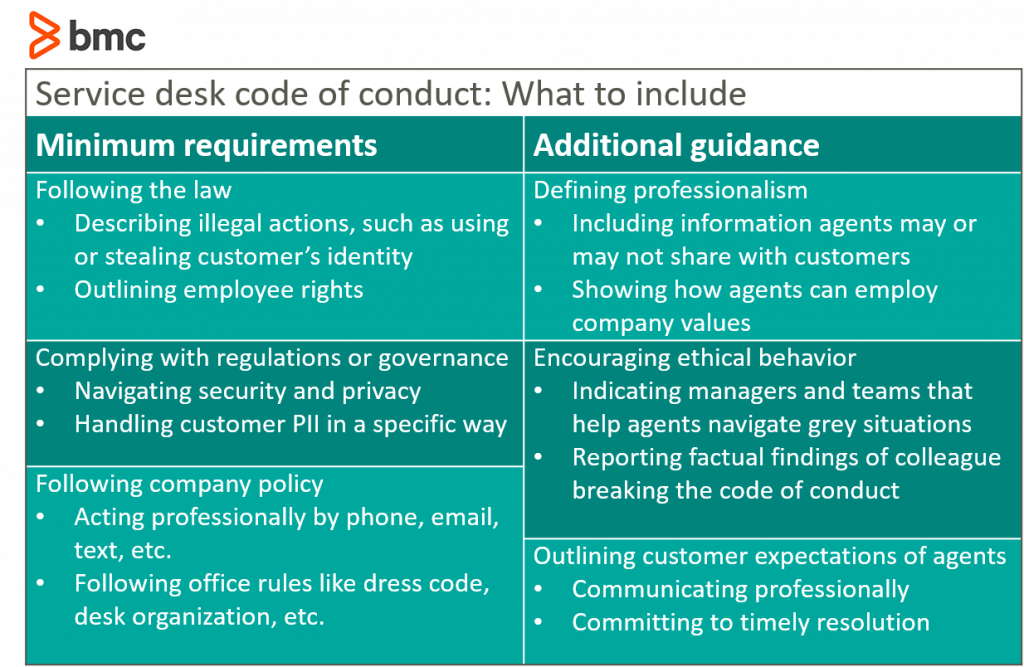A code of conduct is a concept that people in a certain team or social group agree to regarding certain expectations and behaviors. Codes of conduct apply to a variety of settings. Many companies and organizations expect employees to sign or be aware of the company’s code of conduct.
We think a code of conduct can be especially useful in one area of IT service management: the service desk. Your service desk is essential to company success—do well by your customers, and your company will shine. By guiding your service desk agents, you’ll boost their performance. Read on to see how codes of conduct support service desk environments. Or, head right to sections on how to create a conduct code, best practices, and real-world examples.
What is a code of conduct?
A code of conduct is a framework or set of rules. What is included in a conduct code depends on the type of group or team you have. For businesses and organizations, a code of conduct often provides legal guidance for your jurisdiction, regulatory and compliance areas, and recommended behavior in areas that are ethically or otherwise hard to navigate.
This type of document might seem redundant—shouldn’t employees know what’s against the law and what’s bad behavior? But spelling them out in a code of conduct can serve several purposes:
- Documenting expected behaviors, benchmarking employee expectations, trainings, and reviews
- Providing clarity around vague areas of behavior, particularly those of a moral or ethical nature (‘code of ethics’)
- Managing risk and preventing litigation
- Aligning employee behavior with company values
The best codes of conduct support the company culture you desire or aim to maintain. Companies with values like transparency, innovation, and growth opportunities can weave this into the conduct code, providing guidance on how employees can bring these values to life.
Why create a code of conduct for the service desk?
Within any organization, the service desk holds a unique position—daily interactions with customers. Other business units, like finance, marketing, product development, etc., rarely, if ever, talk with customers directly. But the service desk does, and that comes with more responsibility to uphold your company’s reputation.
A code of conduct created specifically for the service desk offers a lot of clarity and benefits. Consider both the company and employee perspectives of what a strong conduct code does:

How to create a service desk code of conduct
A conduct code created for your service desk should align with, not go against, any overarching company conduct code. You may spell out certain points that are already documented that are particularly applicable to service desk agents and managers. Or, you could assume the company code of conduct and addend it with specific service desk rules and expectations.
Because service desk agents routinely deal with the public, your service desk code of conduct should also consider how your business wants to be seen by your customers, your industry, and your local community. (Even tech companies live and work in neighborhoods with other people.)
While the golden rule is good guidance, it falls short of specific actions. When creating a conduct code, consider what to include:

Codes of conduct aren’t only about the content: the way you present it is vital, too. Ensuring your employees actually reference their conduct codes instead of losing them in the bottom desk drawer often comes down to presentation.
Tips for conduct code documentation:
- Write for the reader. Avoid technical jargon or legalese. Instead use action words that your agents can quickly understand.
- Include real-world examples. Every service desk has a few stories that become legend—document them here as a way to show best (or worst) outcomes.
- Make it visually appealing. Page after page of solid text is difficult to navigate. Include images, photos, charts, checklists, FAQs, and a table of contents so agents can quickly find what they need.
- Be concise. You don’t need to account for every single possible scenario. Provide guidance on common situations.
- Place it in an accessible spot. Include a clear link on your intranet landing page, and offer printed copies for those who like a desktop version for quick reference.
Examples of top codes of conducts
Real examples will help you write your service desk code of conduct. Consider these examples of ethical behavior you might expect of your service desk agents:
- Being honest. You could lie about how serious a problem is, your expertise, or the hours you spent fixing an issue. But, by being honest with your customers, you’ll build trust—an important goal for every company.
- Saying no when necessary. A customer engages with the service desk to solve a problem, but sometimes those problems may be more like asking for favors. Do what’s right, but you don’t have to “pull strings” to get a customer on your side. Customers value transparency.
- Focusing on the problem. Take your time to investigate the problem and provide a viable solution. Or, if the customer needs a simple, rote procedure, pay attention that you’re doing it correctly.
- Providing documentation. ITSM ticketing solutions are all about documentation, but it still comes down to what each individual agent includes in a ticket. If you’re not sure about a detail, include it. If you made a promise, deadline, or exception, include it.
- Respecting customers’ confidence. Remember that customers, whether internal or external, may be sharing private details or a situation that may embarrass them. Be discreet: help solve their problem, but don’t publicize that the CTO locked himself out of his email.
- Reporting unethical behavior. You may uncover another agent or manager doing something unethical. If you find this, report it to someone who has the ability and responsibility to intercede. Of course, your report should be based on evidence and truth, not on rumors or suspicions.
- Avoiding company drama. Customers need solutions from your company, not reasons to look elsewhere. Every company has its own internal drama and disagreements. When you, as an agent, are feeling frustrated or disappointed in a company decision or policy, realize that that’s how you see the company. Another customer, especially external, may love your company. Sharing company drama to an undisclosed person reflects poorly on you, the agent, and less on the company.
Your code of conduct should consider not only what your company expects, but what your customers expect. For tech-oriented service delivery, your customers generally expect your service desk agents to:
- Resolve issues within the agreed timeline. If the timeline changes as you learn more, inform the customer in a timely manner.
- Explain the issue and solution clearly. This means using non-technical language so they can make some sense of the issue.
- Provide a consistent experience across agents. This means each agent takes ownership and responsibility for the customer’s issue, no matter who spoke with the customer previously. No passing the buck.
- Manage expectations. Don’t only say that something is impossible today, but give some clarity around your pipeline and workload, especially if it’s a wider problem.
- Offer options for decision-making. If the issue has more than one solution, provide the options to the customer and ask for feedback.
- Treat them respectfully. A kind, professional attitude can go far in problematic situations.
Additional resources
Get an overview of service desk conduct codes with the Service Desk Institute’s Professional Standard: Service Desk Manager (PDF).
For real examples of strong codes of conduct, not all related to the service desk, see:
- Harvard University’s IT Professional Code of Conduct for Protecting Electronic Information
- Microsoft’s Standards of Business Conduct
- PepsiCo’s Global Code of Conduct
- Westinghouse 2019 Code of Conduct (PDF)







